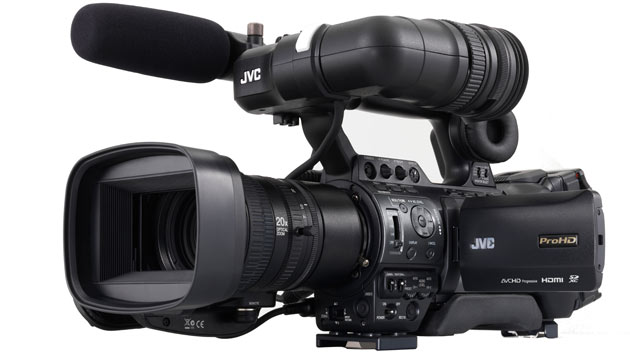ProHD Broadcaster Will Be Available As Hardware or Cloud Service with Monthly Subscription
Continuing its push to make the transmission of live footage easier for news-style shooters in the field, JVC today introduced two shoulder-mount camcorders and announced a new streaming service designed to receive live HD content in broadcast-ready form directly from the cameras.
JVC said it will offer its new ProHD Broadcaster, built around technology from IP-streaming specialist Zixi, based in Waltham, MA, as a physical server or a cloud-based service. The Broadcaster will receive live HD video from JVC cameras with the built-in Zixi engine, which enables real-time streaming via 4G LTE (when connected to a Verizon USB modem) along with recording to on-board memory cards. The Broadcaster can receive simultaneous streams from multiple cameras, which can be switched and broadcast live. That makes it an affordable but reliable option for live coverage from multiple shooters, the company said.
The ProHD Broadcaster will have a suggested list price of $1,995 when it ships next month, the company said, but a subscription to JVC Professional Streaming Services is required for its use. JVC has not officially set the price for a streaming subscription, but we're told it will be in the range of $200-$300/month.
The new cameras, the GY-HM890 ($9,995) and GY-HM850 ($7,995), have what JVC calls Advanced Streaming Technology, which includes content-aware error-correction, bandwidth-shaping, and real-time feedback on streaming conditions that allows the available bandwidth to be used as efficiently as possible for reliable transmission. The new Streamconfidence technology provides real-time feedback on the status of streams and connectivity in the cameras' viewfinders and 4.3-inch LCD monitors.
The 1/3-inch three-CMOS cameras have an interchangeable Fujinon 20x autofocus wide-angle zoom lens. They can record direct to FCP .MOV, XDCAM EX .MP4, AS-10 .MXF, AVCHD .MTS or H.264 .MOV files for NLE compatibility. Both cameras have genlock and timecode, HD_SDI and HDMI out, a 3.5mm headphone jack, and four-channel audio with stereo AUX in and two XLR inputs with phantom power.
So what's the difference? Only the HM890 has a Pool Feed input that can record and stream video and audio from another camera or video source, a function designed for press conferences or other events that make use of a camera pool.
Also built into the new cameras are secure FTP file transfer capabilities and the ability to monitor and control camera and lens functions from an iOS device. Both of the cameras are due in March.
Crafts: Shooting
Sections: Technology
Topics: New product cloud eng final cut pro GY-HM850 GY-HM890 JVC nab 2014 Professional Streaming Services prohd broadcaster
Did you enjoy this article? Sign up to receive the StudioDaily Fix eletter containing the latest stories, including news, videos, interviews, reviews and more.











Leave a Reply